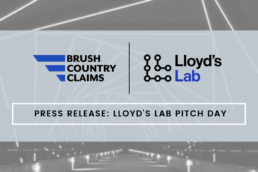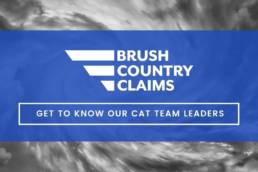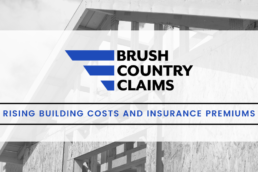What Is Functional Hail Damage?
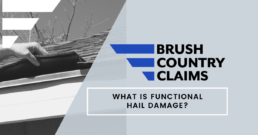
Ever seen hail damage so obvious you don't even climb the roof?
While these losses are uncommon (only about 10% of hailstones are even over 2”, according to the NOAA), the reality is most hail losses are complex and require a detailed eye to properly document the damage. (And you should always climb the roof.)
Hail events can produce a wide variability in damages. Damage which is present on one side of a neighborhood may not exist on the opposite end. As field adjusters, we are responsible for performing a thorough inspection of the insured risk and determining “functional” hail damages that are a direct result of a storm event and that are sudden and accidental in nature.
Shingles can present challenges when inspecting for these functional damages, as there are many “non-functional” or non-peril related damages that may exist. Unfortunately, to the untrained eye, these are often passed off as “hail damage” in photo reports.
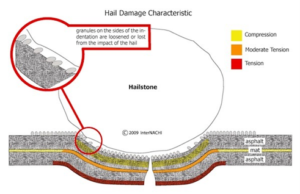 What is functional hail damage?
What is functional hail damage?
The International Association of Certified Home Inspectors defines functional damage as damage that diminishes water shedding ability, and/or reduces the long-term service life of the shingle. Hail damage to asphalt roofing is immediately detectable.
There are some who believe that the damage will show over time with gradual loss of granules due to the initial impact. This is considered light damage and part of normal shingle wear and does not comply with the definition of functional hail damage. At Brush Country Claims, we operate under the idea that functional hail damage will show immediately.
What does functional hail damage look like?
Functional hail damage presents as a concentrated loss of granules that has a somewhat circular shape. The key identifier is a fracture or bruise to the shingle mat. Without this identifier, the damage cannot be classified as hail damage.
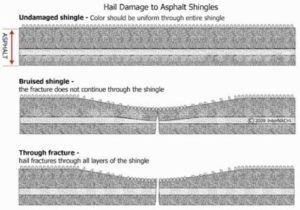 Pro tip: A bruise to a shingle mat will feel similar to a bruise on the skin of an apple.
Pro tip: A bruise to a shingle mat will feel similar to a bruise on the skin of an apple.
These diagrams from InterNACHI show an example of the exaggerated effects of functional hail damage to the shingle.
You can see that the hail strike causes a downward flex of the shingle. The top of the surface is vertically compressed, while the bottom is under horizontal tension.
This creates a crack in the bottom of the shingle, which is why it’s so important to view the underside of the shingle. The second diagram comparatively shows an undamaged, bruised, and fractured shingle.
What is non-functional hail damage?
Non-functional hail damage can also be a somewhat circular concentration of granular loss that exposes an area of asphalt surface but is missing that key identifier of a fracture or bruise to the shingle mat. It will often display as discoloration or anything the alters the appearance of the roofing material and is not considered “functional” in nature.
Non-functional damage may show immediately but can also present weeks, months, or even years down the road and can be attributed to things like heavy rainfall, wind, small hail, or foot traffic. Because none of these conditions are caused by a single, sudden, and accidental occurrence, they should not be classified as functional hail damage.
Pro tip: Hail will not crush stone. If you observe crushed stone, it is not from hail impact.
As representatives of the carrier, we must be diligent, thorough, and complete in our inspections to ensure accuracy of our estimate and keep us compliant with indemnification under the insurance contract. I highly recommend, if the firm or carrier you are working for allows, to share the photo documentation of peril damage, non-peril related damage and no damage areas with the policyholder.
Explain the reason behind your findings or alternate causation to the policyholder and create transparency in the claims process. This will ultimately provide a better experience for the policyholder and will enable them to feel more involved in the process. You can also create a better experience for the policyholder by being communicative and thorough during your inspection.
Remember the definition and presentation of “functional” hail damage as you perform your inspection and explain in detail in your narrative not only what you observed, but what was felt. Your QA supervisor will thank you!
This article was written by Troy Stewart, President and Chief Operating Officer of Brush Country Claims.
Click here to view more of Troy’s content on LinkedIn

About Brush Country Claims
Brush Country Claims is an independent adjusting firm that offers a full claims solution for residential, commercial, daily, and catastrophe claim management. Brush Country utilizes an innovative suite of proprietary technology to maximize customer experience while consistently having some of the fastest cycle times in the industry. A human led, tech forward approach embraces the grassroots beginnings of the company as well as their incredible drive to propel into the future.
Related Posts
July 28, 2021
PRESS RELEASE: Lloyd’s Lab Pitch Day
GEORGETOWN, Texas – July 28, 2021 – Brush Country Claims, a Central Texas-based…
July 12, 2021
Get to Know our CAT Team Leaders
With hurricane season upon us, we wanted to do a little Q&A with our CAT team…
June 28, 2021
Rising Building Costs and Insurance Premiums
In the first half of 2021 we have seen a rapid increase in the price of…

